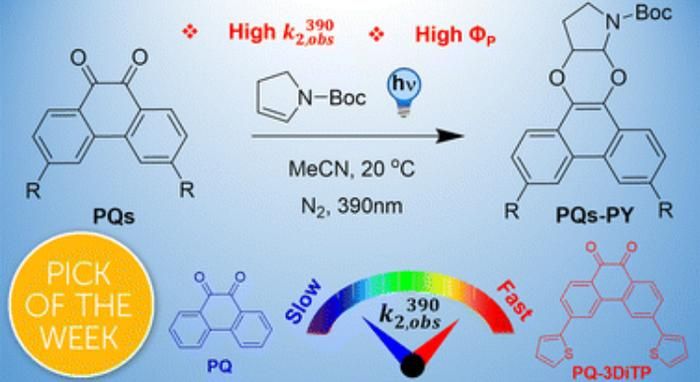In a collaboration between the Universities of Groningen and Amsterdam (Netherlands) and the European Laboratory for Nonlinear Spectroscopy (Italy), the researchers were able to significantly improve photocyclic chemistry. They were able to increase the reactivity of the photocyclic compound in the famous PQ-ERA reaction through strategic molecular substitution. In Chemical Science, the flagship journal of the Royal Society of Chemistry, they report an excellent photocatalytic quantum yield, high reaction rates, and remarkable oxygen tolerance. The paper was designated a Hot Article and Pick of the Week.

At the University of Amsterdam, Michael Hilbers from the Molecular Photonics group and Vibren Jan Puma (Van 'de Hoff Institute for Molecular Sciences) contributed to the synthetic and reaction characterization part of the research conducted in the laboratories of Viktor Szymanski and Nobel Laureates. Ben Feringa at the University of Groningen.
Photoclick chemistry is a light-activated click chemistry (Chemistry Nobel Prize 2022), a collection of elegant and efficient chemical reaction methods that combine dedicated molecular units to yield desired products. Photoclick chemistry has distinct advantages over conventional click chemistry because it allows a greater degree of spatial and temporal control over the reaction. It has a wide range of applications including 3D printing, protein labeling and bioimaging.
PQ-ERA catalyzes the photocyclic reaction
A specific photocyclic reaction is called the PQ-ERA reaction—the light-induced photocoupling of 9,10-phenanthrenequinone (PQ) with electron-rich alkenes (ERA). It has attracted much attention due to its excellent kinetics and biocompatibility. However, commonly used PQ compounds show limited reactivity, which hinders its overall effectiveness.
In a study now presented in Chemical Science, an international research team presents a simple strategy to change that. They describe how a thiophene substitution at the 3-position of the PQ scaffold significantly increases the reactivity of the PQ triplet state to increase the efficiency of the PQ-ERA reaction. Nanosecond time-resolved spectroscopic studies and quantum chemical studies at the Amsterdam Molecular Photonics Group and femtosecond time-resolved spectroscopic studies performed in Florence provided a fundamental understanding of this particular photochemical chemistry. Investigations show that the substitution reaction significantly increases the population of the triplet state (3ππ*) upon induction of 3-thiophene PQs. This results in an excellent photocatalytic quantum yield (FP, up to 98%), high second-order rate constants (K2Until 1974 M–1 s–1), and significant oxygen tolerance for the PQ-ERA reaction system.
These results now pave the way for further development of the reaction, offering better prospects for faster and more efficient photocyclic conversions.

„Oddany rozwiązywacz problemów. Przyjazny hipsterom praktykant bekonu. Miłośnik kawy. Nieuleczalny introwertyk. Student.
